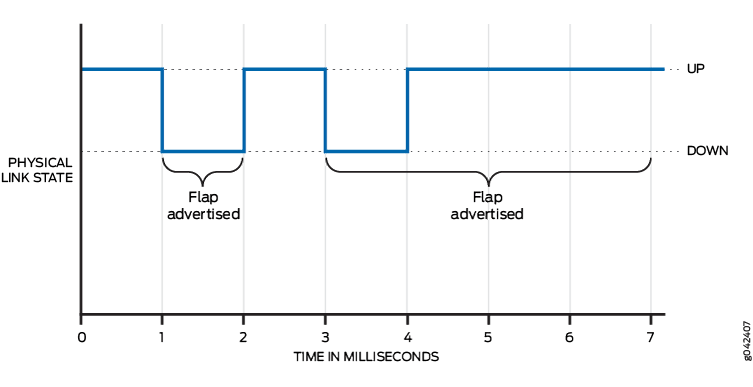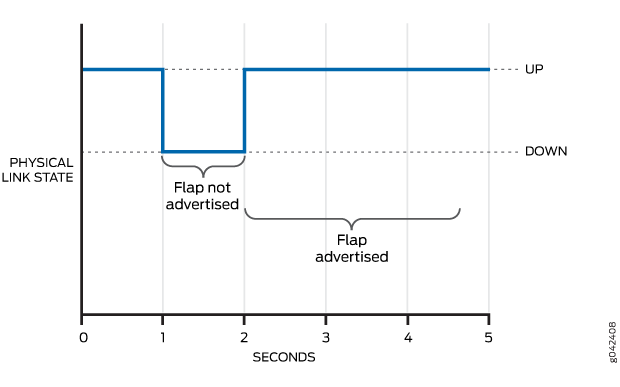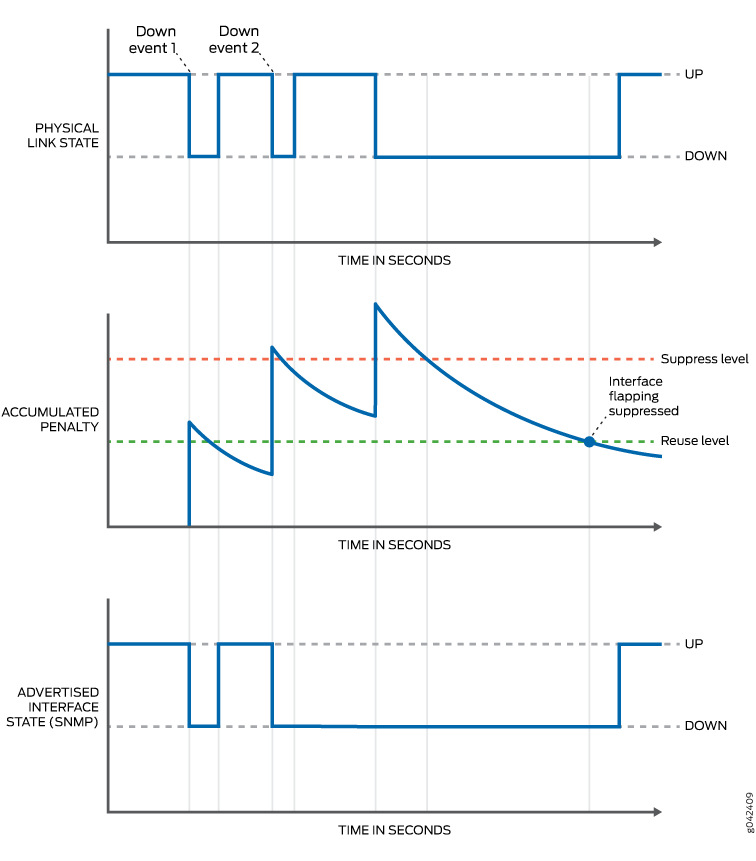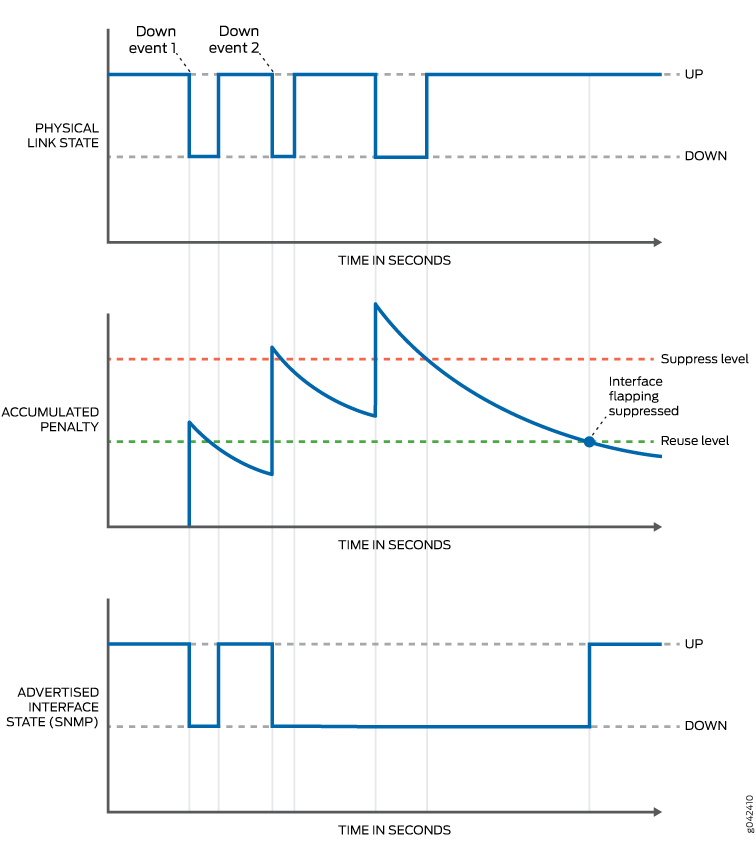Damping Interfaces
You (the network administrator) can configure damping to reduce the advertisement of physical interface transitions between up and down states.
Physical Interface Damping Overview
Physical interface damping limits the advertisement of the up-and-down transitions (flapping) on an interface. Each time a transition occurs, the interface state is changed, which generates an advertisement to the upper-level routing protocols. Damping helps reduce the number of these advertisements.
From the viewpoint of network deployment, physical interface flaps fall into the following categories:
-
Nearly instantaneous multiple flaps of short duration (ms)
-
Periodic flaps of long duration (seconds)
Figure 1 is used to describe these types of interface flaps and the damping configuration that you can use in each case.

We recommend that you use similar damping configurations on both ends of the physical interface. Configuring interface damping on one end and not configuring interface damping on the other end can result in undesired behavior.
The types of interface damping depend upon the transition time length.
- Damping Overview for Shorter Physical Interface Transitions
- Damping Overview for Longer Physical Interface Transitions
Damping Overview for Shorter Physical Interface Transitions
Figure 1 shows two routers with two transport devices between them. If a redundant link between the two transport devices fails, Junos OS performs link switching. Link switching takes a number of milliseconds. As shown in Figure 2, during switching, both device interfaces might encounter multiple flaps with an up-and-down duration of several milliseconds. These multiple flaps, if advertised to the upper-level routing protocols, might result in undesired route updates. This is why you might want to damp these interface flaps. Damping is suitable only with routing protocols.
For shorter physical interface transitions, you configure interface damping with the
hold-time statement on the interface. The hold timer enables
interface damping by not advertising interface transitions until the hold timer
duration has passed. When a hold-down timer is configured and the interface goes
from up to down, the down hold-time timer is triggered. Every interface transition
that occurs during the hold time is ignored. When the timer expires and the
interface state is still down, then the router begins to advertise the
interface as being down. Similarly, when a hold-up timer is configured and an
interface goes from down to up, the up hold-time timer is triggered. Every interface
transition that occurs during the hold time is ignored. When the timer expires and
the interface state is still up, then the router begins to advertise the
interface as being up.

Damping Overview for Longer Physical Interface Transitions
When the link between a router interface and the transport devices is not stable, this can lead to periodic flapping, as shown in Figure 3. Flaps occur in the order of seconds or more, with an up-and-down flap duration in the order of a second or more. In this case, using the hold timer feature might not produce optimal results because it cannot suppress the relatively longer and repeated interface flaps. Increasing the hold-time duration to seconds still allows the system to send route updates on the flapping interface. Increasing the duration therefore fails to suppress periodically flapping interfaces on the system.

For longer periodic interface flaps, configure interface damping with the
damping statement on the interface. This damping method uses an
exponential back-off algorithm to suppress interface up-and-down event reporting to
the upper-level protocols. Every time an interface goes down, Junos OS adds a penalty to the interface penalty counter.
If at some point the accumulated penalty exceeds the suppress level, Junos OS places the interface in the suppress state. In
this case, Junos OS does not report further interface link
up-and-down events to the upper-level protocols.
The penalty added on every interface flap is 1000. At all times, the interface
penalty counter follows an exponential decay process. Figure 4 and Figure 5 show the decay process
as it applies to recovery when the physical level link is down or up. As soon as the
accumulated penalty reaches the lower boundary of the reuse level, the interface is
marked as unsuppressed, and further changes in the interface link state are again
reported to the upper-level protocols. You use the max-suppress
option to configure the maximum time for restricting the accumulation of the penalty
beyond the value of the maximum penalty. The value of the maximum penalty is
calculated by the software. The maximum penalty corresponds to the time it would
take max-suppress to decay and reach the reuse level. The penalty continues to decay
after crossing the reuse level.
Figure 4 and Figure 5 show the accumulated penalty and the decay over time as a curve. Whenever the penalty is below the reuse level and the physical level link changes state, state changes are advertised to the system and cause SNMP state changes.
Figure 4 shows the penalty dropping below the reuse level when the physical link is down. The system is notified of a state change only after the physical level link transitions to up.

Figure 5 shows the penalty dropping below the reuse level when the physical link is up. The system is notified of a state change immediately.

The QFX10002-72Q and QFX10002-36Q switches do not support hold-time
down of less than 1 second on 100G interfaces. The recommended
hold-time down is 3 seconds.
Configure Damping of Shorter Physical Interface Transitions
By default, when an interface changes from up to down or from down to up, this transition is advertised immediately to the hardware and Junos OS. In some situations, you might want to damp interface transitions.
For example, you may want to configure damping on an interface that is connected to an add/drop multiplexer (ADM) or wavelength-division multiplexer (WDM), or to protect against SDH framer holes.
Damping the interface means not advertising the interface’s transition until a certain period of time has passed, called the hold-time. When the interface goes from up to down, the down hold-time timer is triggered. Every interface transition that occurs during the hold time is ignored. If the timer expires and the interface state is still down, then the router begins to advertise the interface as being down. Similarly, when an interface goes from down to up, the up hold-time timer is triggered. Every interface transition that occurs during the hold time is ignored. If the timer expires and the interface state is still up, then the router begins to advertise the interface as being up.
To configure damping of shorter physical interface transitions in ms:
The hold time can be a value from 0 through 4,294,967,295 milliseconds. The default value is 0, which means that interface transitions are not damped. Junos OS advertises the transition within 100 milliseconds of the time value you specify.
For most Ethernet interfaces, Junos OS implements hold timers using a one-second polling algorithm. For 1-port, 2-port, and 4-port Gigabit Ethernet interfaces with small form-factor pluggable (SFP) transceivers, hold timers are interrupt driven.
The hold-time option is not available for controller interfaces.
Configure Damping of Aggregated Ethernet Interface Transitions
By default, when an interface changes from up to down or from down to up, this transition is advertised immediately to the hardware and Junos OS. In some situations, you might want to damp interface transitions.
For example, you may want to configure damping on an interface that is connected to an add/drop multiplexer (ADM) or wavelength-division multiplexer (WDM), or to protect against SDH framer holes.
Damping the interface means not advertising the interface’s transition until a certain period of time has passed, called the hold-time. When the interface goes from up to down, the down hold-time timer is triggered. Every interface transition that occurs during the hold time is ignored. If the timer expires and the interface state is still down, then the router begins to advertise the interface as being down. Similarly, when an interface goes from down to up, the up hold-time timer is triggered. Every interface transition that occurs during the hold time is ignored. If the timer expires and the interface state is still up, then the router begins to advertise the interface as being up.
To configure damping of aggregated ethernet interface transitions in milliseconds:
The hold time can be a value from 0 through 4,294,967,295 milliseconds. The default value is 0, which means that interface transitions are not damped. Junos OS advertises the transition within 100 milliseconds of the time value you specify.
For most Ethernet interfaces, Junos OS implements hold timers using a one-second polling algorithm. For 1-port, 2-port, and 4-port Gigabit Ethernet interfaces with small form-factor pluggable (SFP) transceivers, hold timers are interrupt driven.
You can specify the hold-time value on aggregated ethernet interfaces. When you configure hold-timer for ae- interfaces, we recommend not to configure the hold-time for member links.
The hold-time option is not available for controller
interfaces.
Configure Damping of Longer Physical Interface Transitions
Physical interface damping limits the advertisement of the up-and-down transitions (flapping) on an interface. An unstable link between a router Interface and the transport devices can lead to periodic flapping. Longer flaps occur with a period of about five seconds or more, with an up-and-down duration of one second.
For these longer periodic interface flaps, configure interface damping with the
damping statement on the interface. This damping method uses an
exponential back-off algorithm to suppress interface up-and-down event reporting to the
upper-level protocols. Every time an interface goes down, a penalty is added to the
interface penalty counter. If at some point the accumulated penalty exceeds the suppress
level max-suppress, the interface is placed in the suppress state, and
further interface state up-and-down transitions are not reported to the upper-level
protocols.
You can view the damping parameters with the show interfaces extensive
command.
Use Physical interface damping to confirm platform and release support for specific features.
To configure damping of longer physical interface transitions:
Example: Configure Physical Interface Damping
This example shows how to configure damping for a physical interface on a PTX Series Packet Transport Router.
Requirements
This example uses the following hardware and software components:
One PTX Series Packet Transport Router
One or more routers that provide input packets and receive output packets
Junos OS Release 14.1 or later
Overview
Physical interface damping provides a smoothing of the up-and-down transitions (flapping) on an interface. Each time a transition occurs, the interface state is changed, which generates an advertisement to the upper-level routing protocols. Damping helps reduce the number of these advertisements.
From the viewpoint of network deployment, physical interface flaps fall into these categories:
Nearly instantaneous multiple flaps of short duration (ms). For shorter physical interface transitions, you configure interface damping with the
hold-timestatement on the interface. The hold timer enables interface damping by not advertising interface transitions until the hold timer duration has passed. When you configure a hold-down timer and the interface goes from up to down, the system waits until the interface remains down for the hold-down timer period. Then the system advertises the interface as down. Similarly, when a hold-up timer is configured and an interface goes from down to up, it is not advertised as being up until it has remained up for the hold-up timer period.Periodic flaps of long duration (seconds). For longer periodic interface flaps, you configure interface damping with the
dampingstatement on the interface. This damping method uses an exponential back-off algorithm to suppress interface up-and-down event reporting to the upper-level protocols. Each time an interface goes down, a penalty is added to the interface penalty counter. If at some point the accumulated penalty exceeds the suppress level, the interface is placed in the suppress state, and further interface state up transitions are not reported to the upper-level protocols.
Configuration
CLI Quick Configuration
To quickly configure this example, copy the following commands and paste into a TXT. Remove any
line breaks and change any details to match your network configuration. Copy and
paste the commands into the CLI at the [edit] hierarchy
level.
set interfaces xe-6/0/0 damping half-life 11 max-suppress 2222 reuse 3333 suppress 4444 enable
Procedure
Step-by-Step Procedure
To configure damping on the PTX Series Packet Transport Router:
Set the half-life interval, maximum suppression, reuse, suppress values, and enable:
[edit interface] user@router# set xe-6/0/0 damping half-life 11 max-suppress 2222 reuse 3333 suppress 4444 enable
-
Commit the configuration:
[edit] user@router# commit
Results
From configuration mode, confirm your configuration
by entering the show interfaces command. If the output
does not display the intended configuration, repeat the instructions
in this example to correct the configuration.
user@router# show interfaces
xe-6/0/0 {
damping {
half-life 11;
max-suppress 2222;
reuse 3333;
suppress 4444;
enable;
}
Verification
To confirm that the configuration is working properly, perform this task:
Verify Interface Damping on xe-6/0/0
Purpose
Verify that damping is enabled on the interface and that the damping parameter values are correctly set.
Action
From operational mode, run the show interfaces
extensive command.
user@router# run show interfaces xe-6/0/0 extensive Physical interface: xe-6/0/0, Enabled, Physical link is Up Interface index: 158, SNMP ifIndex: 535, Generation: 161 Link-level type: Ethernet, MTU: 1514, LAN-PHY mode, Speed: 10Gbps, BPDU Error: None, Loopback: None, Source filtering: Disabled, Flow control: Enabled Device flags : Present Running Interface flags: SNMP-Traps Internal: 0x4000 Link flags : None CoS queues : 8 supported, 8 maximum usable queues Hold-times : Up 0 ms, Down 0 ms Damping : half-life: 11 sec, max-suppress: 2222 sec, reuse: 3333, suppress: 4444, state: unsuppressed
Meaning
Damping is enabled and configured successfully on the xe-6/0/0 interface.
